Related Research Articles
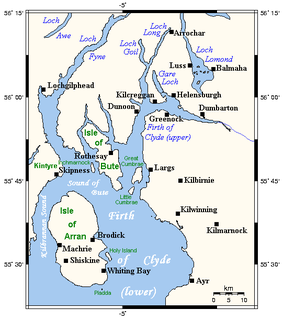
The Firth of Clyde is the mouth of the River Clyde and the deepest coastal waters in the British Isles, sheltered from the Atlantic Ocean by the Kintyre peninsula which encloses the outer firth in Argyll and Ayrshire. The Kilbrannan Sound is a large arm of the Firth of Clyde, separating the Kintyre Peninsula from the Isle of Arran. Within the Firth of Clyde is another major island – the Isle of Bute. Given its strategic location, at the entrance to the middle/upper Clyde, Bute played a vitally important military (naval) role during World War II.
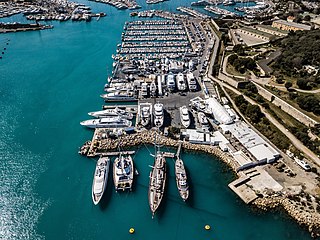
A shipyard is a place where ships are built and repaired. These can be yachts, military vessels, cruise liners or other cargo or passenger ships. Dockyards are sometimes more associated with maintenance and basing activities than shipyards, which are sometimes associated more with initial construction. The terms are routinely used interchangeably, in part because the evolution of dockyards and shipyards has often caused them to change or merge roles.
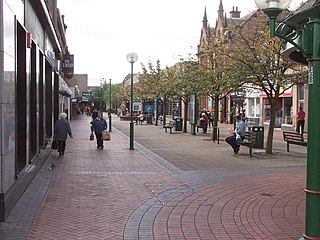
Grangemouth is a town in the Falkirk council area, Scotland. Historically part of the county of Stirlingshire, the town lies in the Forth Valley, on the banks of the Firth of Forth, 3 miles (4.8 km) east of Falkirk, 5 miles (8.0 km) west of Bo'ness and 13 miles (20.9 km) south-east of Stirling. Grangemouth had a resident population of 17,906 according to the 2001 Census. Preliminary figures from the 2011 census reported the number as 17,373.
British Shipbuilders (BS) was a public corporation that owned and managed the shipbuilding industry in Great Britain from 1977 through the 1980s. Its head office was at Benton House in Newcastle upon Tyne, England.
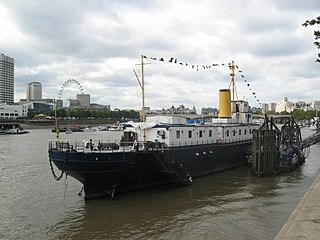
The twenty-eight Anchusa-class sloops were built under the Emergency War Programme for the Royal Navy in World War I as the final part of the larger "Flower class", which were also referred to as the "Cabbage class", or "Herbaceous Borders".

Ailsa Shipbuilding Company was a Scottish shipbuilding company based in Troon and Ayr, Ayrshire.
Seawind Barclay Curle is a British shipbuilding company.
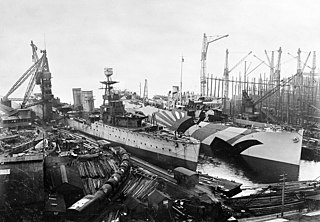
Scotts Shipbuilding and Engineering Company Limited, often referred to simply as Scotts, was a Scottish shipbuilding company based in Greenock on the River Clyde. In its time in Greenock, Scotts built over 1,250 ships.
Lithgows Limited, is a family-owned Scottish company that had a long involvement in shipbuilding, based in Kingston, Port Glasgow on the River Clyde in Scotland. It has a continued involvement in marine resources.

The Aubrietia-class sloops were a class of twelve sloops built under the Emergency War Programme for the Royal Navy in World War I as part of the larger Flower class. They were also referred to as the "cabbage class", or "herbaceous borders". The Flowers were the first ships designed as minesweepers.
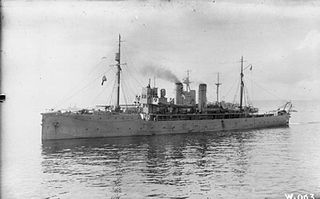
The Acacia class was a class of twenty-four sloops that were ordered in January 1915 under the Emergency War Programme for the Royal Navy in World War I as part of the larger Flower class which were also referred to as the "Cabbage class", or "Herbaceous Borders". They were ordered in two batches, twelve ships on 1 January and another twelve on 12 January, and all were launched within about four or five months, and delivered between May and September 1915. They were used almost entirely for minesweeping until 1917, when they were transferred to escort duty.

The 24 class was a class of minesweeping sloops. They were derived from the preceding Flower-class sloop, but designed to appear double-ended. Twenty-four ships to this design were ordered between December 1916 and April 1917 under the Emergency War Programme for the Royal Navy in World War I, although two of them were cancelled before launch. All were named after famous racehorses, but they were not named Racehorse class as the Admiralty realised that this could easily be confused in communications with the Racecourse class of paddle minesweepers, and they officially became the 24 class.
The Greenock Dockyard Company was a Scottish shipbuilding and ship repair firm located at Greenock, on the River Clyde.
References
- Falkirk Council (2008). "Ship making, shipping industry, marine engines" (PDF). Guide to archives. Falkirk Community Trust. Retrieved 23 September 2012.
- "Records of Greenock Dockyard Co Ltd, Greenock, Inverclyde, Scotland". Archives hub. Glasgow University Archive Services. 2002. Retrieved 6 January 2009.
- McIntyre, Alastair. "History of Grangemouth". Electric Scotland. Scottish Studies Foundation. Retrieved 6 January 2009.
- Nasaw, David (2006). Andrew Carnegie . Penguin. ISBN 0-14-311244-9.